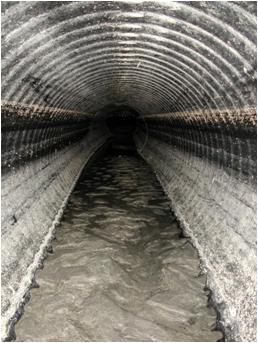GET CULTURED: Drainage channels and vegetated filter strips in nurseries Part I
by Don Merhaut
In the following two-article series, different types of drainage channels will be described.
Part I: In this first article, the different types of drainage channels will be described along with the advantages and disadvantages of different types of systems. Non-vegetated drains will be highlighted.
Part II: In the next article, we will focus on vegetative filter strips, providing information on plant performance, plant selection and maintenance issues. The use of vegetation in drainage ditches, fields and slopes to remediate nutrients, pesticides and sediments will also be discussed.
Vegetated and non-vegetated drainage channels can be used to remediate storm water and irrigation runoff that may occur from agricultural production. Primary and secondary functions of both of these types of drainage channels are listed in table 1. When deciding what type of drainage channel to install, vegetated or non-vegetated, one must decide on the purpose of the drainage channel. If runoff is inevitable, the use of vegetative filter strips can reduce the amount of nutrients, pesticides and sediments before water flows off of the property. If feasible, it may be cost effective to recycle runoff water back into the nursery since this will reduce fertilizer and water costs. If water recycling is practiced, conveying water to collection ponds should be done with the use of non-vegetated channels. Pipes and/or gravel, concrete or fabric-lined channels are options.
| Table 1. Primary and Secondary Functions of Vegetated and Non-Vegetated Drainage channels | |
| Primary | 1. Directing water flow away from production areas to capturing/recycling basins or to other treatment areas such as vegetated filter strips and constructed wetlands before discharge from the property. |
| 2. Mitigating nutrients, pesticides and sediments from runoff water before the water enters the watershed. | |
| Secondary | 1. For vegetated channels, production of ornamental crops with high water demands, such as cannas. |
| 2. For vegetated channels, production of vegetation for use as compost or mulch. | |
When constructing non-vegetated drainage channels or installing pipes, take into consideration: (1) angle of slopes, (2) water flow during normal flow rates, (3) water flow during major storm events, (4) safety issues, (5) leaching into groundwater and (6) local regulations. The ability to remove sediment should also be taken into consideration. Sediment accumulation into drainage ditches and pipes is one of the bigger concerns (fig. 1). Therefore, the primary maintenance issue with these systems is the periodic dredging of sediment. Three variables will increase the amount of sediment that accumulates in drains: (1) sediment-laden water sources; (2) water flowing through unprotected, erosion-susceptible land and (3) low-slope angles of drainage areas. Costly dredging can be minimized by using cleaner water sources, preventing erosion in ditches, and where possible, increasing the slope of drainage channels, so that drainage water does not stay in drains. If sediment is a problem or low-slope angles are unavoidable, do not use gravel, since it will be difficult, if not impossible to remove sediment from gravel. Fabric-lined ditches may also be problematic, since many fabrics break down over time. However, on steeper slopes, gravel and/or fabrics can be used since there is less likelihood of sediment accumulation and gravel and fabric will reduce erosion of native soil.

Fig. 1. Inside of a five-feet diameter drainage pipe. Sediment has accumulated on the bottom of this drain as a result of erosion from ditches leading to it. Photo by Donald Merhaut.
Donald Merhaut is UC Cooperative Extension Specialist for Nursery and Floriculture Crops, Department of Botany and Plant Sciences, UC Riverside.












